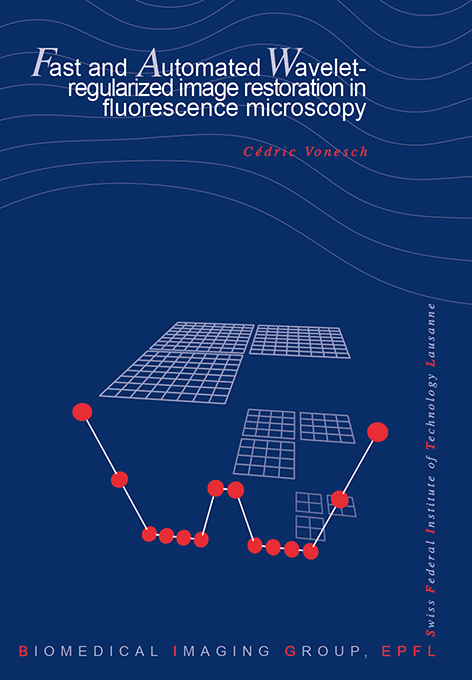Fast and Automated Wavelet-Regularized Image Restoration in Fluorescence Microscopy
C. Vonesch
SSBE research award, École polytechnique fédérale de Lausanne, EPFL Thesis no. 4306 (2009), 229 p., May 1, 2009.
The subject of this thesis is image restoration, that is, deconvolution and denoising. Our work is motivated by applications in the rapidly expanding field of biological imaging and in particular fluorescence microscopy. Inverse problems in this area typically involve regularly structured but high-dimensional data sets, thus requiring a specific tradeoff between restoration quality, computational complexity and user interaction. Our interest lies in novel algorithmic solutions for addressing these challenges. The common point of our developments is that they rely centrally on wavelets and multilevel concepts.
The thesis is organized in three main parts. In the first part, we provide a general overview of fluorescence microscopy in the context of biological research. We then review the current state of the art in deconvolution microscopy, within a unifying variational framework.
The second part is concerned with deconvolution using a non-quadratic (typically ℓ1) wavelet-domain regularization. In the context of deconvolution microscopy, this approach is novel. It amounts to imposing a sparsity constraint on the object to be recovered, a concept that has recently attracted considerable interest in signal and image processing. This type of regularization was shown to belong to the most effective restoration methods, but it involves a computationally challenging optimization problem. We propose a multilevel version of the standard "thresholded Landweber" algorithm that yields a substantial acceleration. This allows us to apply wavelet regularization to large-scale deconvolution problems encountered in deconvolution microscopy.
In the third part, we present some applications of risk estimation techniques for automating the process of image restoration. We first propose a denoising method that is specifically designed for very low light intensities. The algorithm is designed from the beginning for complete self-adjustment of its parameters and for low computational complexity. It also performs competitively with most existing approaches for Poisson intensity estimation. Our second contribution is a general method for estimating the signal-to-noise ratio during the execution of iterative image-restoration procedures; it is applicable to most algorithms emanating from variational formulations, in particular those involving wavelet regularization.

@PHDTHESIS(http://bigwww.epfl.ch/publications/vonesch0902.html,
AUTHOR="Vonesch, C.",
TITLE="Fast and Automated Wavelet-Regularized Image Restoration in
Fluorescence Microscopy",
SCHOOL="{\'{E}}cole polytechnique f{\'{e}}d{\'{e}}rale de {L}ausanne
({EPFL})",
YEAR="2009",
type="{EPFL} Thesis no.\ 4306 (2009), 229 p.",
address="",
month="May 1,",
note="{SSBE} research award")